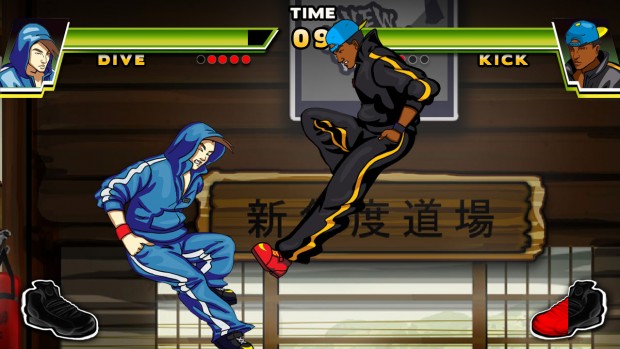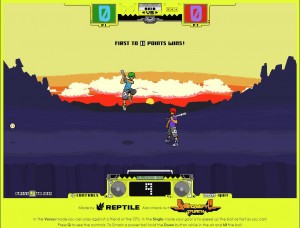Indie Rock: Lethal League
- Updated: 8th May, 2013

I’m learning from watching streams of Iron Galaxy’s upcoming “Divekick” that the important parts of fighting games are being actively withheld by the high barrier to success. Divekick is about ripping away the unimportant parts of the genre to get to the high level play immediately and leaving players with just two buttons, one that kicks and one that dives. There’s more to it than that, but if you can press two buttons, you can play Divekick.
Long combo entry to perform flashy highly damaging moves is a hallmark of the genre. Practicing to make sure you’ve mastered the button presses ensures that players stick around a long time and figure out new techniques, but this has never made the games better. It means that the length of time from becoming interested in having fun by virtually punching and kicking your friend is extended unnecessarily.
It’s what prevents these games from being any good at parties; in theory you can rotate a controller around and get a fun time out of taking each other down, but new people are going to be too overwhelmed and not understand the real depth.
Fighting games are as much about anticipating your opponent through observation and baiting them out rather than throwing out whatever you think will work, but that’s just not knowledge that’s useful for someone who doesn’t know how to take advantage of systems.
Divekick isn’t out yet, so I haven’t had a chance to find out if it’s as good as it seems at introducing laymen. What I’ve played instead is Lethal League. It’s somehow about as mechanically stripped down as Divekick and yet maybe even more interesting.
You control one of two dudes holding baseball bats. There’s a baseball in the middle of the map. If you hit the baseball with your bat it’ll travel faster in the opposite direction. If you’re hit by the ball you lose a round. First player to 11 rounds wins.
 What’s so great about Lethal League is that the above is basically the extent of the mechanics. The complexity comes from your position in relation to your opponent and the ball.
What’s so great about Lethal League is that the above is basically the extent of the mechanics. The complexity comes from your position in relation to your opponent and the ball.
You can spend a while turned totally away from the other player hitting the thing against a wall to build momentum then jump out of the way unexpectedly leaving them unprepared. You could angle the ball vertically so it’s trickier to predict the pathing, or you could just volley it back and forth until one of you inevitably messes up.
Rather than contain a timer that counts down to zero, the ball gradually becomes unmanageably fast to the point where your only chance if hitting it is inputting the strike command long before it’s anywhere near you. At that point the game’s less about directing the attack on the other player and just doing your best to remain safe. One of you will lose at some point.
The best mechanic isn’t even connected to the scoring system. When you’re hit, your character faints and drops their bat. Before the next round loads in, the other player is able to smack away the body or the bat. It serves as a bragging move that ups the competitive atmosphere, but doesn’t do anything else. It’s a great addition on par with ending a round in a more traditional fighting game and keeping a combo going juggling your opponent.
It took a matter of minutes from starting to figure out the controls before my co-op partner and I were coming up with high-level techniques. We’re nearly masters of this, it’s barely been hours since we’ve started and we’ve no intention of ever moving on.
Oh, Also
I’m coming to terms with the knowledge that I’m basically a voyeur. Twine games continue to be great about giving glimpses into lives that I’ll probably never experience and I’m not going to stop playing them until I get caught.
This week’s window is into a conversation between Lim designer Merritt Kopas and her mother. It tasks you with selecting conversational pieces and ways in which the mother can address Merritt, displaying her willingness to come to terms with her daughter’s gender transition through tiny word choices.
 What Conversations With My Mother conveys, presumably to you as well (I’m not going to tell you what to take away from whatever I’m talking about. I’m just here to tell you it’s cool) is a sense of awkwardness when tripping over the use of specific pronouns even though it’s not actually difficult at all to get right. You can understand the thought process of a woman not quite sure how to say “daughter” to someone she’d always called “son”, even if from our perspective of the event the choice is just as simple as picking from that or two better options.
What Conversations With My Mother conveys, presumably to you as well (I’m not going to tell you what to take away from whatever I’m talking about. I’m just here to tell you it’s cool) is a sense of awkwardness when tripping over the use of specific pronouns even though it’s not actually difficult at all to get right. You can understand the thought process of a woman not quite sure how to say “daughter” to someone she’d always called “son”, even if from our perspective of the event the choice is just as simple as picking from that or two better options.
The the way the reality is eventually conveyed (in a way that I won’t spoil) does a lot to help with empathising how much effect such a small move toward acceptance can be for someone and how making the slightest concessions to your own comfort can mean so much to someone else.
Twine’s great. We like Twine here.

Follow Us!